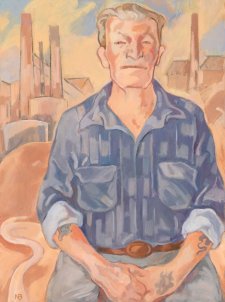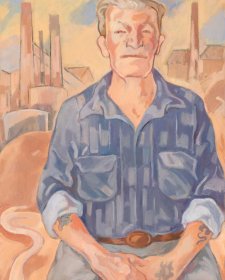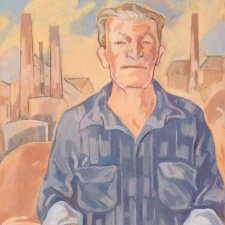- About us
- Support the Gallery
- Venue hire
- Publications
- Research library
- Organisation chart
- Employment
- Contact us
- Make a booking
- Onsite programs
- Online programs
- School visit information
- Learning resources
- Little Darlings
- Professional learning
James (Jim) McClelland (1915–1999), lawyer, politician, judge and newspaper columnist, was born in Melbourne and educated at Catholic boys’ schools there and in Ballarat. At seventeen, he won a scholarship to the University of Melbourne but completed his arts degree part-time while working in a clerical job with the Victorian railways department and becoming increasingly involved in left-wing politics. After war service with the RAAF, he moved to Sydney, completed a law degree and began practising as a solicitor. In 1970, he was elected a Labor senator for New South Wales and in the third of Gough Whitlam’s ministries held the portfolios of Manufacturing Industry and Labour and Immigration. He left Federal politics in 1978. Chief Justice of the New South Wales Land and Environment Court between 1980 and 1985, McClelland became widely known as the chairman of the 1984–85 Royal Commission into British nuclear weapons testing in Australia (at Maralinga). He was also a great patron of the theatre in Australia, involved in establishing the Sydney Theatre Company in 1978 and serving as its founding Chairman, and associated with the founding of the Belvoir Street Theatre in 1984. On retiring from the bench, he started writing for the Sydney Morning Herald, contributing a regular column in which he criticised former colleagues including Lionel Murphy, Neville Wran, Bob Hawke and Paul Keating; accordingly, he was demonised by the Labor Party. His autobiography, Stirring the possum, was published in 1989.
New Zealand-born painter Nancy Borlase (1914–2006) arrived in Sydney at age twenty-three and enrolled at East Sydney Technical College, supporting herself while studying with waitressing and life- modelling. In the late 1930s she moved to Melbourne and there commenced a relationship with trade unionist Laurie Short (1915–2009), whom she married in 1941. Moving back to Sydney, Borlase joined the Contemporary Art Society and held her first solo exhibition in 1960; between 1973 and 1981 she was art critic for the Bulletin and the Sydney Morning Herald. Borlase won the Portia Geach Prize for portraiture in 2000. She painted this portrait of McClelland, a friend of her husband’s, in 1946, long before McClelland’s expensive taste in clothes gained him the nickname ‘Diamond Jim’.
Collection: National Portrait Gallery
Gift of Gillian Appleton (McClelland) 1999
Donated through the Australian Government's Cultural Gifts Program
© Estate of Nancy Borlase
Gillian Appleton (1 portrait)



On one level The Companion talks about the most famous and frontline Australians, but on another it tells us about ourselves.



Dr Sarah Engledow delves into the life of union leader Pat Mackie who is depicted in a portrait by Nancy Borlase AM.



Visit us, learn with us, support us or work with us! Here’s a range of information about planning your visit, our history and more!